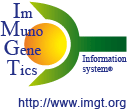IMGT unique numbering for G-DOMAIN and G-LIKE-DOMAIN
In order to easily compare the characteristic groove domain (G-DOMAIN) of the major histocompatibility complex (MH) chains from vertebrates, and the G-LIKE-DOMAIN of the MH superfamily (MhSF) proteins of all species, an IMGT unique numbering has been defined [1]. The IMGT unique numbering for G-DOMAIN is part of the 'NUMEROTATION' concept of IMGT-ONTOLOGY [2].
Lefranc, M.-P. et al., Dev. Comp. Immunol., 29, 917-938 (2005) PMID: 15936075
This IMGT unique numbering relies on the high conservation of the structure of the G-DOMAIN.
The G-DOMAIN corresponds to:
- domain 1 [D1] and domain 2 [D2] of a MH1-Alpha chain
- domain 1 [D1] of a MH2-Alpha chain
- domain 1 [D1] of a MH2-Beta chain.
The IMGT unique numbering for G-DOMAIN also applies to G-LIKE-DOMAIN. A G-LIKE-DOMAIN is a groove domain of similar 3D structure as the G-DOMAIN, found in chains other than MH.
'IMGT Protein display for G domain' header:
![]()

IMGT unique numbering for G-DOMAIN
A MH1 protein comprises one MH1-Alpha (MH1-ALPHA) chain and one Beta2-Microglobulin (B2M) chain. The MH1-ALPHA chain consists of three domains: [D1] and [D2] are G-DOMAIN, and domain [D3] is a C-LIKE. The B2M chain consists of a single C-LIKE.
A MH2 protein comprises one MH2-Alpha (MH2-ALPHA) chain and one MH2-Beta (MH2-BETA) chain. Each chain consists of two domains: domain 1 is a G-DOMAIN and domain 2 is a C-LIKE.
The G-DOMAIN consists of one sheet of four antiparallel beta strands ("floor" of the groove or platform) and one long helical region ("wall" of the groove). This groove is part of the cleft that is the peptide binding site of the classical MH1 and MH2 proteins.
The G-DOMAIN are designated as:
- G-ALPHA1 (G-DOMAIN corresponding to domain 1 of a MH1-ALPHA chain)
- G-ALPHA2 (G-DOMAIN corresponding to domain 2 of a MH1-ALPHA chain)
- G-ALPHA (G-DOMAIN of a MH2-ALPHA chain)
- G-BETA (G-DOMAIN of a MH2-BETA chain)
The IMGT numbering for G-DOMAIN was established by extensive sequence alignment comparison of annotated MH chains from the IMGT Repertoire (MH) and by structural data anlysis and alignment of MH proteins with known 3D structures from IMGT/3Dstructure-DB [1]. As each G-DOMAIN is usually encoded by a single exon, the delimitation of the domains in IMGT takes into account the limits of the exons in the genomic structure of the MH genes.
For each G-DOMAIN, the positions that contribute to the groove floor comprise IMGT positions 1 to 49, with the A strand from positions 1 to 14, the AB turn positions 15 to 17, the B strand positions 18 to 28, the BC turn positions 29 and 30, the C strand positions 31 to 38, the CD turn positions 39 to 41 and the D strand positions 42 to 49. The additional position 7A represents a bulge in 3D structures and is present in some G-ALPHA domains. Additional positions at the N-terminus of strand A or at the C-terminus of strand D can be added if necessary [2].
For each G-DOMAIN, the positions that contribute to the helix comprise IMGT positions 50 to 92. The numbering of the alpha helix starts at position 50 and ends at position 92, with five additional positions at 54A, 61A, 61B, 72A and 92A. Three of them (61A, 61B, 72A) characterize the G-ALPHA2 and/or G-BETA domains. The position 92A is occupied, for example in human and mouse, in the MH2-DMA G-ALPHA domains. It is worthwhile to note that position 54A is the only additional position needed to extend the IMGT numbering for G-DOMAIN to the G-LIKE-DOMAIN of the RPI-MH1Like proteins.
| IMGT G-DOMAIN strand, turn and helix |
Groove floor | Helix | ||||||
|---|---|---|---|---|---|---|---|---|
| A strand |
AB turn |
B strand |
BC turn |
C strand |
CD turn |
D strand |
||
| Amino acid numbering |
1.9-1.1 1-14 |
15-17 | 18-28 | 29-30 | 31-38 | 39-41 | 42-49 49.1-49.5 |
50-92 |
IMGT unique numbering for G-LIKE-DOMAIN
The G-LIKE-DOMAIN are designated as:
- G-ALPHA1-LIKE (G-LIKE-DOMAIN corresponding to domain 1 of a RPI-MH1Like-Alpha chain)
- G-ALPHA2-LIKE (G-LIKE-DOMAIN corresponding to domain 2 of a RPI-MH1Like-Alpha chain).
The IMGT unique numbering for G-LIKE-DOMAIN (proteins other than MH) follows exactly the same rules are those of the G-DOMAIN. As mentioned above, position 54A is the only additional position needed to extend the IMGT numbering for G-DOMAIN to the G-ALPHA1-LIKE of the RPI-MH1Like proteins.
The IMGT unique numbering for the G-LIKE-DOMAIN allows, for the first time, to compare any G-DOMAIN and G-LIKE-DOMAIN of any protein of the MH superfamily (MhSF).
Correspondence between G numberings
| [1] | Lefranc, M.-P. et al., Dev. Comp. Immunol., 29, 917-938 (2005)
PMID: 15936075,
LIGM:296
|
| [2] | Giudicelli, V. and Lefranc, M.-P., Bioinformatics, 15, 1047-1054 (1999)
PMID:10745995,
LIGM:221
|
- We thank Elsevier and Developmental and Comparative Immunology, for allowing IMGT to make available the DCI pdf file on the IMGT site.



